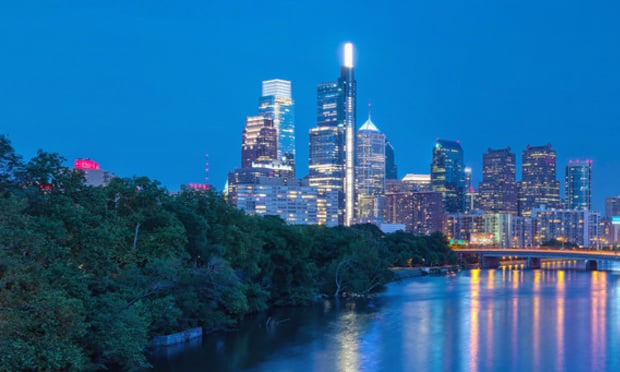MALVERN, PA—Office workers continue to have limited access to daylight, experience poor air quality and uncomfortable temperatures and are distracted by too much noise in their workplace, according to a new national survey by a global building products company.
The responses from 400 office workers surveyed nationally by Saint-Gobain, one of the world's largest building materials companies, point to a need to improve the quality of the office environment nationwide by creating spaces that are built to benefit employee well-being.
Such improvements, the study suggests, can have a significant impact on productivity, and ultimately, a company's bottom line.
“The office environment is one of the most important elements of any company because it significantly impacts the most valuable asset — employees. With workplace satisfaction and productivity at stake, we believe it's time workplaces reflect their significance,” says John Crowe, president and CEO of Saint-Gobain and CertainTeed Corporations. “For this reason, Saint-Gobain recently opened a new 65-acre North American headquarters that is designed to improve the quality of our employees' lives and, in doing so, inspire them to create the next chapter of our 350-year innovation legacy.”
Saint-Gobain and its subsidiary SageGlass, which makes “electrochromic” glass that adjusts to daylight, conducted the study, which it called the 2016 Work Environment Survey. As previously reported by GlobeSt.com, Saint-Gobain's new office campus in Malvern, about 25 miles southwest of Philadelphia, embraces open, collaborative space designs, SageGlass windows, and other design elements that address the study's work environment concerns.
“We've found that the expectations and the opportunities for people who work in these buildings has gone up,” Carmen Ferrigno, vice president of communications at Saint-Gobain, and a leader of the Work Environment Survey, tells GlobeSt.com exclusively. “Once you start that dialogue, you really do open a lot of doors in terms of how these buildings could adapt to people. Once you start asking the people who work there what they want out of the building, they really start to push the envelope. We've found that asking the occupants what their expectations are, you really find a better way to drive the evolution of buildings.”
One of the top factors affecting employee well-being is natural light. In fact, nearly nine in 10 (87 percent) survey respondents said they would prefer to work near a window most of the time. Despite this overwhelming desire to be exposed to natural light, 36 percent of office workers do not have a window near their work space.
Of those with access to a window, 65 percent have blinds or curtains that block sunlight at least some of the day. It's not just sunlight being blocked, but the restorative benefits of the outdoors. In fact, 32 percent of those with window access rarely or never see pleasant vistas.
Those with access to daylight and views of the outdoors are experiencing the benefits, the survey showed. Among those who reported seeing sunlight at work, approximately two-thirds (68 percent) indicated sunlight improves their mood, while nearly half (47 percent) felt sunlight makes them more energized and around 4 in 10 felt more relaxed (41 percent) and less stressed (36 percent). More than a quarter (28 percent) felt exposure to sunlight at work makes them more productive.
Beyond sunlight, a connection to the natural environment was also found to have a significant impact on well-being, but too few are connecting to the outdoors. Only a quarter of those surveyed can see outdoor scenery and nearly one-third (32 percent) rarely or never see it. This is especially concerning when you consider the restorative benefits of nature that could be realized if more employees had access to outdoor views. More than half felt looking at natural scenery while at work relaxed them (61 percent), provided a good way to take a break (60 percent) and reduced their stress level (53 percent).
Millennials appear to be somewhat more adaptable and to new office designs and environments, says Ferrigno. “Gen-Xers and Baby Boomers are a little more reticent,” he says. “They tend to hang back a bit. Millennials are used to having a more fluid environment, but I'm finding that the Baby Boomers are the best advocates for this because their initial resistance is so high.”
“Daylight and a connection to the outdoors have a powerful impact on employee well-being and it's concerning that many office workers spend most of their day in an environment with no access to natural light,” says Dr. Alan McLenaghan, CEO of SageGlass. “No matter the size or location of a company, the workplace is at the heart of a strong internal culture and therefore should be a space that is healthy and comfortable. If companies want happier and more productive employees, it's time to evaluate the workplace they're providing.”
Additional Survey Highlights:
- The Temperature is Rarely Just Right - The majority of office workers felt that at least sometimes the temperature at work was too cool (73 percent) and/or too warm (63 percent).
- Many Offices Have Poor Air Quality – Nearly half of respondents felt that at least sometimes at work they experienced stale air/poor air quality (47 percent) and/or there was not enough humidity/too dry (46 percent).
- Noise is Problematic – Nearly two-thirds (65 percent) of office workers found themselves distracted and/or irritated by too much noise at work at least sometimes.
- Access to Sunlight Impacts Job Satisfaction – Office workers who rarely or never see sunlight at work were less likely to be satisfied with their job than those who see sunlight at work at least sometimes (57 percent vs. 75 percent, respectively).
- Artificial Lighting and Sunlight Need Better Control – In regards to lighting from sunlight and artificial lighting, more than one-third of office workers felt the following applied at work at least sometimes: the lighting was too bright (46 percent), irritating (36 percent) and/or distracting (36 percent).
CORRECTION, 6/3/2016: Because of an editing error in an earlier version of this article, a Saint-Gobain executive was incorrectly identified as Carmine Ferrigno. His name is Carmen Ferrigno.
MALVERN, PA—Office workers continue to have limited access to daylight, experience poor air quality and uncomfortable temperatures and are distracted by too much noise in their workplace, according to a new national survey by a global building products company.
The responses from 400 office workers surveyed nationally by Saint-Gobain, one of the world's largest building materials companies, point to a need to improve the quality of the office environment nationwide by creating spaces that are built to benefit employee well-being.
Such improvements, the study suggests, can have a significant impact on productivity, and ultimately, a company's bottom line.
“The office environment is one of the most important elements of any company because it significantly impacts the most valuable asset — employees. With workplace satisfaction and productivity at stake, we believe it's time workplaces reflect their significance,” says John Crowe, president and CEO of Saint-Gobain and CertainTeed Corporations. “For this reason, Saint-Gobain recently opened a new 65-acre North American headquarters that is designed to improve the quality of our employees' lives and, in doing so, inspire them to create the next chapter of our 350-year innovation legacy.”
Saint-Gobain and its subsidiary SageGlass, which makes “electrochromic” glass that adjusts to daylight, conducted the study, which it called the 2016 Work Environment Survey. As previously reported by GlobeSt.com, Saint-Gobain's new office campus in Malvern, about 25 miles southwest of Philadelphia, embraces open, collaborative space designs, SageGlass windows, and other design elements that address the study's work environment concerns.
“We've found that the expectations and the opportunities for people who work in these buildings has gone up,” Carmen Ferrigno, vice president of communications at Saint-Gobain, and a leader of the Work Environment Survey, tells GlobeSt.com exclusively. “Once you start that dialogue, you really do open a lot of doors in terms of how these buildings could adapt to people. Once you start asking the people who work there what they want out of the building, they really start to push the envelope. We've found that asking the occupants what their expectations are, you really find a better way to drive the evolution of buildings.”
Want to continue reading?
Become a Free ALM Digital Reader.
Once you are an ALM Digital Member, you’ll receive:
- Breaking commercial real estate news and analysis, on-site and via our newsletters and custom alerts
- Educational webcasts, white papers, and ebooks from industry thought leaders
- Critical coverage of the property casualty insurance and financial advisory markets on our other ALM sites, PropertyCasualty360 and ThinkAdvisor
Already have an account? Sign In Now
*May exclude premium content© 2024 ALM Global, LLC, All Rights Reserved. Request academic re-use from www.copyright.com. All other uses, submit a request to [email protected]. For more information visit Asset & Logo Licensing.










